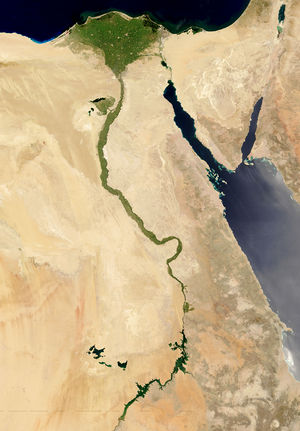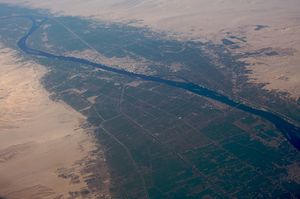Nile River: Difference between revisions
imported>Richard Nevell (Created page with "{{subpages}} {{Image|Nile NASA, 2004.jpg|thumb|300px|This aerial photograph shows the Nile flowing through Egypt. About 6,695km in length, it extends further south through other...") |
imported>Richard Nevell No edit summary |
||
| Line 3: | Line 3: | ||
{{Image|Nile NASA, 2004.jpg|thumb|300px|This aerial photograph shows the Nile flowing through Egypt. About 6,695km in length, it extends further south through other countries.}} | {{Image|Nile NASA, 2004.jpg|thumb|300px|This aerial photograph shows the Nile flowing through Egypt. About 6,695km in length, it extends further south through other countries.}} | ||
The '''Nile''' is one of the longest rivers in the world at about 6,695km from its source in the south to the [[Mediterranean Sea]] in the north.<ref>[http://www.guinnessworldrecords.com/records-3000/longest-river/ Longest River], ''Guinness World Records''. Accessed 27 December 2012.</ref> | The '''Nile''' is one of the longest rivers in the world at about 6,695km from its source in the south to the [[Mediterranean Sea]] in the north.<ref>[http://www.guinnessworldrecords.com/records-3000/longest-river/ Longest River], ''Guinness World Records''. Accessed 27 December 2012.</ref> The Nile floods predictably in about August each year. The [[silt]] deposited on the floodplains fertilises the ground and leaves it suitable for agriculture. The river has a significant impact on the surrounding area, making it suitable for inhabitation, and while in Egypt the surrounding area is desert, the land close to the Nile is fertile and productive.<ref>Manley, Bill (1996). ''The Penguin Historical Atlas of Ancient Egypt''. London: Penguin. p. 18. ISBN 0-14-051331-0.</ref> When the [[Roman Empire|Romans]] conquered Egypt its produce was shipped to feed the populous of [[Rome]], and Egypt was dubbed the "breadbasket of the Empire".<ref>Baker, Charles F. and Baker, Rosalie, F. (2001). ''Ancient Egyptians:People of the Pyramids: People of the Pyramids''. Oxford: Oxford University Press. p. 177. ISBN 978-0-19-512221-3.</ref> | ||
{{Image|Nile aerial, 2009.jpg|left|300px|Beyond the reach of the Nile, Egypt gives way to dry, infertile desert.}} | {{Image|Nile aerial, 2009.jpg|left|300px|Beyond the reach of the Nile, Egypt gives way to dry, infertile desert.}} | ||
There has historically been debate about which is the longest river in the world: the Nile, or the [[Amazon River|Amazon]] in [[South America]]. Throughout the 20th century the Nile was considered longer. Though [[Brazil]]ian scientists renewed the Amazon's claims in 2007, Glenn Switkes of the International Rivers Network remarked that the matter was "trivial".<ref>Roach, John (18 June 2007). "[http://news.nationalgeographic.co.uk/news/2007/06/070619-amazon-river.html Amazon Longer Than Nile River, Scientists Say]", ''National Geographic News. Accessed 27 December 2012.</ref> | |||
==References== | |||
{{reflist}} | {{reflist}} | ||
Revision as of 10:00, 27 December 2012

This aerial photograph shows the Nile flowing through Egypt. About 6,695km in length, it extends further south through other countries.
The Nile is one of the longest rivers in the world at about 6,695km from its source in the south to the Mediterranean Sea in the north.[1] The Nile floods predictably in about August each year. The silt deposited on the floodplains fertilises the ground and leaves it suitable for agriculture. The river has a significant impact on the surrounding area, making it suitable for inhabitation, and while in Egypt the surrounding area is desert, the land close to the Nile is fertile and productive.[2] When the Romans conquered Egypt its produce was shipped to feed the populous of Rome, and Egypt was dubbed the "breadbasket of the Empire".[3]

Beyond the reach of the Nile, Egypt gives way to dry, infertile desert.
There has historically been debate about which is the longest river in the world: the Nile, or the Amazon in South America. Throughout the 20th century the Nile was considered longer. Though Brazilian scientists renewed the Amazon's claims in 2007, Glenn Switkes of the International Rivers Network remarked that the matter was "trivial".[4]
References
- ↑ Longest River, Guinness World Records. Accessed 27 December 2012.
- ↑ Manley, Bill (1996). The Penguin Historical Atlas of Ancient Egypt. London: Penguin. p. 18. ISBN 0-14-051331-0.
- ↑ Baker, Charles F. and Baker, Rosalie, F. (2001). Ancient Egyptians:People of the Pyramids: People of the Pyramids. Oxford: Oxford University Press. p. 177. ISBN 978-0-19-512221-3.
- ↑ Roach, John (18 June 2007). "Amazon Longer Than Nile River, Scientists Say", National Geographic News. Accessed 27 December 2012.